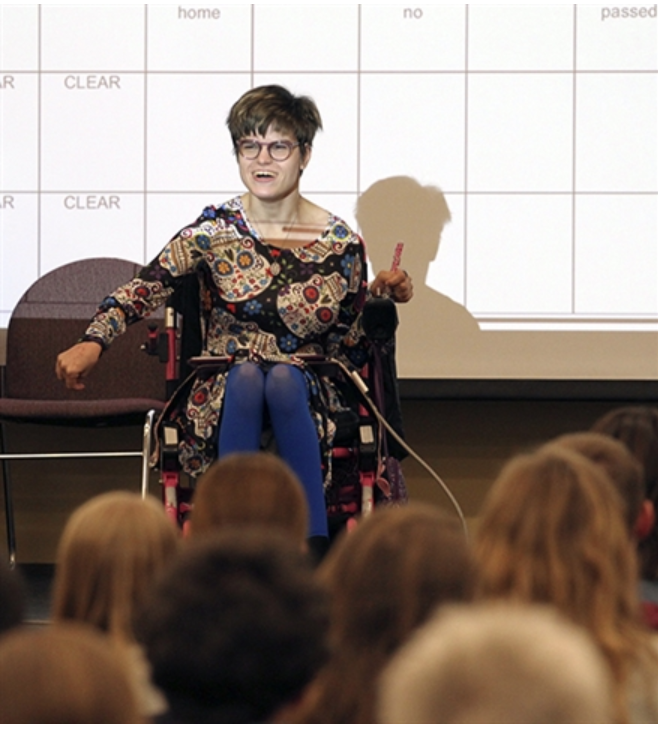Funny. Smart. Strong.
This is Lydia Dawley.

Even though Lydia doesn’t speak a word, she told her amazing story to a packed audience of students, faculty, and guests at Winona State University’s Disability is Natural Cultural Fair. Organized by students enrolled in an ever-popular course called Disability Communication and Culture, the Fair is designed to provide publicity about the culture of disability. Surrounded by easels showcasing colorful artwork created by those in the community with a spectrum of disabilities, we watched as Lydia navigated the wooden ramp in her hot pink wheelchair and took center stage.
For those unfamiliar with disability, it can feel awkward and uncomfortable. The anxiety in the room was palpable until Dr. Kelly Herold, the teacher who welcomed us to the event, said something that made us laugh. We watched as Lydia threw her head back chuckling–clearly finding Herold’s comments funny, and just like that, the tension disappeared. The brief history the professor provided about the great distance the disability community has traveled; from institutionalization, to genocide, to the Gang of 19, to the Americans with Disabilities Act, to the mainstreaming of students engaged us, equipped us with context, and got us ready to listen and learn.
Funny.
Attired in a colorful dress and bright blue tights, Lydia centered her iPad on her lap, then using her microphone-shaped device, began pressing tiles on her tablet. As she selected and pushed the tiles, the words Lydia had written transformed into speech. She described how during birth the umbilical cord had been wrapped around her neck causing a lack of oxygen, resulting in the diagnosis of spastic quadriplegic cerebral palsy, which causes a lack of muscle control, tightness, and spasticity. But, with a mischievous smile she assured us, “my sense-of-humor is working just fine.” Lydia went on to explain cerebral palsy is not contagious, is not progressive, and is not curable.
Smart.
As a senior at the University of Wisconsin-Whitewater, Lydia is studying to become a speech language pathologist assistant and was recently accepted into the SLPA program at Northern Arizona University. Lydia manages many of the same college life stressors and pressures as her able-bodied peers, like meeting the same coursework deadlines and living with roommates. Beyond her work in disability advocacy and speaking, Lydia is one of two developers of an assistive speaking device-the software she used to present her speech-and is on track to graduate in May, 2020.
Strong.
One afternoon while traveling across campus, Lydia’s battery powered wheelchair and iPad lost power and she was unable to move her wheelchair or to communicate. A college student offered assistance, then realizing Lydia was unable to talk with her, called police. Later, safely back in her dorm, Lydia did what many college students do, she posted about her experience on Facebook. Her post, “I wasn’t even in college for one month, and someone called the cops on me!” instigated a phone call from her concerned parents, a thread of surprise from friends, and some laughter for Lydia. Late at night on a different day, Lydia lost battery power when she was in the student commons of her dormitory. Determined not to spend the night in her wheelchair, she got onto the floor and pulled herself 50 feet to her room. When she awoke the next morning, she noticed her arms and legs were covered with carpet burns from her one-and-one-half hour long quest.
This is Lydia Dawley.
Lydia’s Message
On that cold evening in October, Lydia’s message warmly washed over the audience. Slowly and with effort, Lydia emphasized that just like in our relationships with people who are able-bodied, there is no “one-right-way” to relate to people with disabilities. She then asserted how important it is to strive to look beyond a person’s disability and to recognize and focus on the capability, perseverance, and humanness of the person in front of us. “Those with disabilities,” she reminded, “want friendships and the opportunity to live like everyone else.” In closing, Lydia revealed her mindset, “I could stay home and feel sorry for myself or I could change the world. I decided to change the world.”
Teaching and Learning about Disability
Lydia’s speech was emotional, enlightening and thought-provoking. What I learned left me curious about the methods we use to teach and learn about disabilities in our schools and communities. Below are some of the questions Lydia’s speech initiated in me. The hope is that you, too, will consider these questions for yourself, your students, your classroom, your school, and your community:
|
|
A list of resources to support learning more about disability culture:
Please enjoy more photos from the Disability is Natural Culture Fair:
Students, faculty and guests gathered to listen to Lydia’s message. On the screen were picture tiles Lydia selects when communicating:

Easels displayed art painted by those with disabilities from urban and rural communities in Minnesota. The paintings represented all age groups and were created by people with a variety of physical and cognitive disabilities:

A drone photo captured students meeting the requirement for using the paintings “in a creative way to elevate disability awareness:”

Lydia answered questions and visited with students, faculty and guests after her speech:

You can find Lydia Dawley on Facebook.







